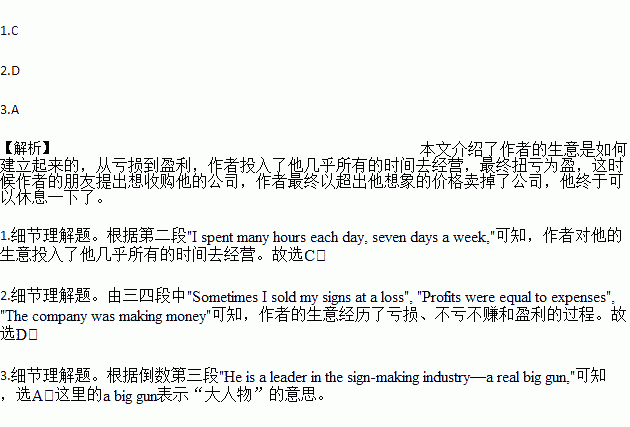题目内容
I had started a small company several years ago. I worked hard to make it successful. It was a sign-making business. It was a small company, and it was private.
Still, I worked hard building up my business. I did not work only a few hours each day—no banker's hours for me. Instead I spent many hours each day, seven days a week, trying to grow the company. I never cut corners or tried to save on expenses. I made many cold calls. I called on possible buyers from a list of people I had never seen. Such calls were often hard sells.
Sometimes I sold my signs at a loss. I did not make money on my product. When this happened, there were cut backs. I had to use fewer supplies and reduce the number of workers. But after several years, the company broke even. Profits were equal to expenses. And soon after, I began to gain ground. My signs were selling very quickly. They were selling like hotcakes.
I was happy. The company was moving forward and making real progress. It was in the black, not in the red. The company was making money, not losing it.
My friend knew about my business. He is a leader in the sign-making industry—a real big gun, if you know what I mean. He offered to buy my company.
He offered me a ball park estimate of the amount he would pay to buy my company. But I knew his uneducated guess was low. My company was worth much more. That is, he asked his accountant to take a close look at the finances of my company and decide how much it was worth. Then my friend increased his offer.
My friend's official offer was finally given to me in black and white. It was written on paper and more than I ever dreamed. I was finally able to get a break. I made a huge profit on my company, and my friend also got a bang for the buck. He got a successful business for the money he spent.
1.What's the author's attitude towards his business?
A. He worked like a banker.
B. He showed no interest in it.
C. He devoted almost all his time to it.
D. He didn't expect to make money from it.
2.Which of the following matches the author's business?
A. Making neither a loss nor a profit→making money→running at a loss.
B. Making money→running at a loss→making neither a loss nor a profit.
C. Making neither a loss nor a profit→running at a loss→making money.
D. Running at a loss→making neither a loss nor a profit→making money.
3.What did the author think of his friend?
A. A big gun. B. A proud fellow.
C. A selfish guy. D. A stubborn man
| A. | when | B. | what | C. | how | D. | that |
| 例如: It was very nice to get your invitation to spend∧weekend with you.Luckily the I was completely free then,so I'll t0 say"yes".I'll arrive in Bristol at around 8 p.m.am in Friday evening. on |
very nice of you,Mother.So I didn't think she looked like Grandma.""Neither did me,"said Mother cheerfully.
| A. | whose | B. | that | C. | which | D. | where |

